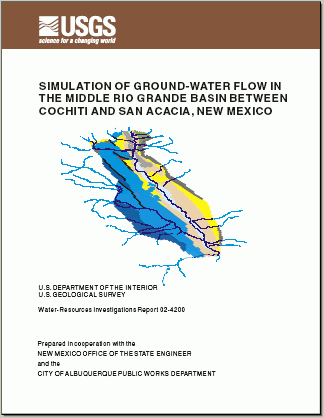Water-Resources Investigations Report 02-4200
U.S. Geological Survey Water-Resources Investigations Report 02-4200, 81 pages (Published 2002)
By Douglas P. McAda and Peggy Barroll
Prepared in Cooperation with the NEW MEXICO OFFICE OF THE STATE ENGINEER and the CITY OF ALBUQUERQUE PUBLIC WORKS DEPARTMENT
![]() This report is available online in pdf format: USGS WRIR 02-4200 (4 MB)
This report is available online in pdf format: USGS WRIR 02-4200 (4 MB)
The model code and data are available as a ZIP file (5.7Mb).

This report describes a three-dimensional, finitedifference, ground-water-flow model of the Santa Fe Group aquifer system within the Middle Rio Grande Basin between Cochiti and San Acacia, New Mexico. The aquifer system is composed of the Santa Fe Group of middle Tertiary to Quaternary age and post-Santa Fe Group valley and basin-fill deposits of Quaternary age.
Population increases in the basin since the 1940ís have caused dramatic increases in ground-water withdrawals from the aquifer system, resulting in large ground-water-level declines. Because the Rio Grande is hydraulically connected to the aquifer system, these ground-water withdrawals have also decreased flow in the Rio Grande. Concern about water resources in the basin led to the development of a research plan for the basin focused on the hydrologic interaction of ground water and surface water (McAda, D.P., 1996, Plan of study to quantify the hydrologic relation between the Rio Grande and the Santa Fe Group aquifer system near Albuquerque, central New Mexico: U.S. Geological Survey Water-Resources Investigations Report 96-4006, 58 p.). A multiyear research effort followed, funded and conducted by the U.S. Geological Survey and other agencies (Bartolino, J.R., and Cole, J.C., 2002, Ground-water resources of the Middle Rio Grande Basin, New Mexico: U.S. Geological Survey Circular 1222, 132 p.). The modeling work described in this report incorporates the results of much of this work and is the culmination of this multiyear study.
The purpose of the model is (1) to integrate the components of the ground-water-flow system, including the hydrologic interaction between the surface-water systems in the basin, to better understand the geohydrology of the basin and (2) to provide a tool to help water managers plan for and administer the use of basin water resources. The aquifer system is represented by nine model layers extending from the water table to the pre-Santa Fe Group basement rocks, as much as 9,000 feet below the NGVD 29. The horizontal grid contains 156 rows and 80 columns each spaced 3,281 feet (1 kilometer) apart. The model simulates predevelopment steady-state conditions and historical transient conditions from 1900 to March 2000 in 1 steady-state and 52 historical stress periods. Average annual conditions are simulated prior to 1990, and seasonal (winter and irrigation season) conditions are simulated from 1990 to March 2000. The model simulates mountain-front, tributary, and subsurface recharge; canal, irrigation, and septic-field seepage; and ground-water withdrawal as specified-flow boundaries. The model simulates the Rio Grande, riverside drains, Jemez River, Jemez Canyon Reservoir, Cochiti Lake, riparian evapotranspiration, and interior drains as head-dependent flow boundaries.
Hydrologic properties representing the Santa Fe Group aquifer system in the ground-water-flow model are horizontal hydraulic conductivity, vertical hydraulic conductivity, specific storage, and specific yield. Variable horizontal anisotropy is applied to the model so that hydraulic conductivity in the north-south direction (along model columns) is greater than hydraulic conductivity in the east-west direction (along model rows) over much of the model. This pattern of horizontal anisotropy was simulated to reflect the generally north-south orientation of faulting over much of the modeled area. With variable horizontal anisotropy, horizontal hydraulic conductivities in the model range from 0.05 to 60 feet per day. Vertical hydraulic conductivity is specified in the model as a horizontal to vertical anisotropy ratio (calculated to be 150:1 in the model) multiplied by the horizontal hydraulic conductivity along rows. Specific storage was estimated to be 2 x 10-6 per foot in the model. Specific yield was estimated to be 0.2 (dimensionless).
A ground-water-flow model is a tool that can integrate the complex interactions of hydrologic boundary conditions, aquifer materials, aquifer stresses, and aquifer-system responses. This groundwater- flow model provides a reasonable representation of the geohydrologic processes of the basin and simulates many historically measured trends in flow and water levels. By simulating these complex interactions, the ground-water-flowmodel described in this report can provide a tool to help water managers plan for and administer the use of basin water resources. Nevertheless, no ground-water model is unique, and numerous sources of uncertainty remain. When using results from this model for any specific problem, those uncertainties should be taken into consideration.
Abstract
Introduction
Purpose and scope
Previous investigations
Acknowledgments
Geohydrology of the Middle Rio Grande Basin
Geologic setting
Surface-water hydrology
Ground-water hydrology
Mountain-front and tributary recharge
Subsurface recharge
Ground-water withdrawal
Ground-water flow and ground-water/surface-water interaction
Hydrologic properties
Model description
Numerical method
Spatial discretization
Time discretization
Boundary conditions
Specified flows
Head-dependent flows
Aquifer representation
Model development and calibration
Calibration targets
Water-level data
Flow data
Development and adjustments of model parameters
Mountain-front recharge
Tributary recharge
Subsurface recharge
Canal seepage
Crop-irrigation seepage
Septic-field seepage
Ground-water withdrawal
Rio Grande
Riverside drains
Interior drains
Jemez River
Jemez Canyon Reservoir
Cochiti Lake
Riparian evapotranspiration
Aquifer properties
Calibration results
Predevelopment heads
Well hydrographs
Recent water-level maps
Vertical hydraulic gradients
Rio Grande surface-water system
Water budget
Model sensitivity
Summary and conclusions
References
Supplemental information
Modification to well package
Subroutine GWF1WEL6FM
Subroutine GWF1WEL6BD
Modification to layer property flow package
Subroutine GWF1LPF1AL
Subroutine GWF1LPF1FM
Subroutine SGWF1LPF1B
Subroutine SGWF1LPF1F
Subroutine SGWF1LPF1VCOND
![]() This report is available online in pdf format: USGS WRIR 02-4200 (4 MB)
This report is available online in pdf format: USGS WRIR 02-4200 (4 MB)
To view the PDF document, you need the Adobe Acrobat® Reader installed on your computer. (A free copy of the Acrobat® Reader may be downloaded from Adobe Systems Incorporated.)